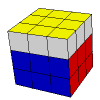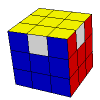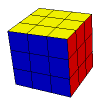
| Beginner | Intermediate | Advanced | Notation |
This step aims to complete the last face, regardless of the position of the cubies, like this:


Perhaps unsurprisingly, we're going to do this in two steps (hence the '2-look').
Step the first: get a cross on the top face. You should already know how to do this, but you can remind yourself here.
At this point, we can be a little clever if we find ourselves presented with this:
.png) |
R U2 R2' F R F' U2' R' F R F' |
Instead of the beginner method of using both F U R U' R' F' and F R U R' U' F' and having to spin the cube about in the middle, this algorithm flips all the edges in one go and saves us a little time and effort. There are loads of algorithms to do this, but I like this one best. Alternatively, you could just stick to the beginner way, but this algorithm will come back when you learn proper OLL and you'll feel all smug when you already know it.
Step the second: orient the corner cubies.
Much like the beginner method, the rest of the last layer isn't an intuitive thing you can just work out (if you can, go work for NASA or something). Unfortunately, this means you have to just learn which algorithms correspond to which case. Fortunately, there are only seven of them and they're all in this handy-dandy table:
 |
R' U2 R U R' U R |  |
L' U R U' L U R' |
 |
L U' R' U L' U R U R' U R |  |
R U R' U R U' R' U R U2 R' |
 |
R' F' L F R F' L' F |  |
R' F' L' F R F' L F |
 |
R' F' L' F R F' L F |
This step aims to orient the corners in their correct positions, like this:

Continuing the 2-look theme, we're going to do this in two steps. First, the corners. To do this, you need to find two corners that have opposite colours, like this:

where the indicated sides of the corners are the same colour. Occasionally, all of the opposite sides will be the same colour. In this case, it does not matter which way you hold the cube when performing the algorithm. When doing the algorithm, you hold the cube so the opposite colours are in the same place as indicated in the above picture.
The algorithm is: x R2 D2 R U R' D2 R U' R (where x means to rotate the cube away from you, i.e. the yellow face is the back face.)
If all of the opposite sides were the same colour before, you will have to repeat this process, as now there is only one opposite pair.
Now, the corners.
This step aims to orientate the edges of the cross, resulting in a complete cube, like such:

You will either have one or no correct edges to being with. If you have one, hold the correct one away from you, but if you have none it does not matter which way you hold it.
There are two algorithms to use, but they are very similar:
 |
F2 U L R' F2 L' R U F2 |
 |
F2 U' L R' F2 L' R U' F2 |
Once this algorithm has been done, you have completed the Magic Cube!
Congratulations!
Top of page